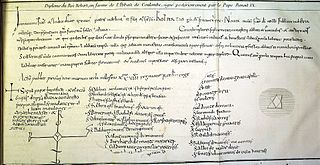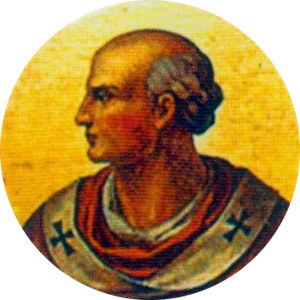External links
 This article incorporates text from a publication now in the public domain : Herbermann, Charles, ed. (1913). "Bonizo of Sutri". Catholic Encyclopedia . New York: Robert Appleton Company.
This article incorporates text from a publication now in the public domain : Herbermann, Charles, ed. (1913). "Bonizo of Sutri". Catholic Encyclopedia . New York: Robert Appleton Company.
Bonizo of Sutri or Bonitho was a Bishop of Sutri and then of Piacenza in central Italy, in the last quarter of the 11th century. He was an adherent of Gregory VII and an advocate of the reforming principles of that pope. He wrote three works of polemical history, including Liber ad amicum , which detailed the struggles between civil and religious authorities. He was driven out of both of his dioceses, once by the emperor and once by opponents of Gregorian-style reform.
Bonizo was born about 1045, though there is no documentary material referring to the date of his birth, or the place, or of his family. [1] It is argued that he was a native of Milan in Northern Italy. [2] Early in his life he associated himself with the reform group known as the Pataria.
Bonizo took part in several councils held in Rome. He was present in Rome at a synod of Pope Alexander II, probably the one held in February or March 1073. [3]
On 27 November 1074, Pope Gregory wrote a letter to Bishop Dionysius of Piacenza, advising him that he was sending legates (who were carrying the letter) in order to settle several long-running disputes which raged in that diocese, and occasioned accusations in the Papal Court. These disputes included the Bishop, on the one side, and the Abbot of S. Sepulcro; the People of Piacenca; and the subdeacon Bonizo. [4] Bishop Dionysius was the leading opponent in Lombardy of the reforming party of which Gregory VII had just become the head. It is conjectured that the subdeacon was the future Bonizo of Sutri. [5] Bonizo was present at the Roman synod of February 1075, in which Bishop Dionysius was deposed. [6]
He was soon appointed by the Pope to the episcopal see of Sutri. The earliest reference to him as Bishop of Sutri is found in the dedicatory inscription of the church of S. Thomas in Cremona, on 3 October 1078. He was serving as papal legate at the time. [7] He was present in Rome during the discussions about the doctrines concerning the eucharist promoted by Berengar of Tours, just before the Roman synod of November 1078. [8]
In the struggle between Gregory VII and Emperor Henry IV he was on the side of the pope. He was seized by Henry in late April 1082, and entrusted to the custody of the antipope Clement III, Archbishop Wibert of Ravenna. About a year afterwards Bonizo made his escape, and lived for several years under the protection of Countess Matilda of Tuscany. [9]
In 1086 he was present in Mantua at the funeral of his friend Anselm of Lucca, who had died on 18 March 1086. [10] He was, soon after, elected to the see of Piacenza by the Pataria, but owing to strong opposition was unable to take possession of it until the year 1088, when he was strongly supported by Pope Urban II. His enemies, however, contrived to have him blinded and maimed in July 1090. [11] He seems to have died in Cremona in 1094 or 1095. [12]

Pope Alexander II, born Anselm of Baggio, was the head of the Roman Catholic Church and ruler of the Papal States from 1061 to his death in 1073. Born in Milan, Anselm was deeply involved in the Pataria reform movement. Elected according to the terms of his predecessor's bull, In nomine Domini, Anselm's was the first election by the cardinals without the participation of the people and minor clergy of Rome. He also authorized the Norman Conquest of England in 1066.

Pope Benedict IX, born Theophylactus of Tusculum in Rome, was the bishop of Rome and ruler of the Papal States for three periods between October 1032 and July 1048. Aged about 20 when first elected, he is the youngest pope in history. He is the only person to have been Pope more than once and the only person ever accused of selling the papacy.

Pope Gregory VII, born Hildebrand of Sovana, was head of the Catholic Church and ruler of the Papal States from 22 April 1073 to his death in 1085. He is venerated as a saint in the Catholic Church.
Pope Damasus II was the Bishop of Rome and ruler of the Papal States from 17 July 1048 to his death on 9 August that same year. He was the second of the German pontiffs nominated by Emperor Henry III. A native of Bavaria, he was the third German to become pope and had one of the shortest papal reigns.

Benedict X, born Giovanni, was elected to succeed Pope Stephen IX on 5 April 1058, but was opposed by a rival faction that elected Nicholas II. He fled Rome on 24 January 1059 and is today generally regarded as an antipope.
Honorius II, born Pietro Cadalo, was an antipope from 1061 to 1072. He was born in the County of Verona, and became bishop of Parma in 1045. He died at Parma in 1072.
Theodoric was an antipope in 1100 and 1101, in the schism that began with Wibert of Ravenna in 1080, in opposition to the excesses of Pope Gregory VII and in support of the Emperor Henry IV.

Bruno di Segni was an Italian Roman Catholic prelate and professed member from the Order of Saint Benedict who served as Bishop of Segni and Abbot of Montecassino. He studied under the Benedictines in Bologna before being appointed a canon of the cathedral chapter of Siena. He was invited to Rome where he became a bishop and counselled four consecutive popes. He served as Abbot of Montecassino but when he criticised Pope Paschal II regarding the Concordat of Ponte Mammolo in 1111 the pope relieved him of his duties as abbot and ordered Bruno to return to his diocese, where he died just over a decade later. Bruno's canonization was celebrated on 5 September 1181 under Pope Lucius III who presided over the celebration in the late bishop's diocese.

Ruthard was Archbishop of Mainz from 1089 to 1109, and a leading opponent of the Emperor Henry IV and his antipope Clement III. He spent nearly eight years in exile because of his opposition, and played a part in the successful revolt of Henry V against his father.

The Archdiocese of Salzburg is a Latin Church archdiocese of the Catholic Church in Austria. The archdiocese is one of two Austrian archdioceses, serving alongside the Archdiocese of Vienna.

The 1073 papal election saw the election of Hildebrand of Sovana as successor to Pope Alexander II.
Benzo of Alba was an Italian bishop. He was an opponent of Gregorian reform who supported Henry IV of Germany in the Investiture Controversy.
The Annales Romani are a set of annals covering the history of the city of Rome in the 11th–12th centuries, with entries for the years 1044–1073, 1100–1121 and 1182–1187. The earlier periods correspond to the periods of the Gregorian Reform and the Investiture Controversy, and the Annales thus form an important source on those events. David Whitton remarks that "no historian of eleventh and early twelfth century Rome or of the Reform Papacy can advance very far in his studies without giving attention to the Annales Romani." The Annales are rich in detail, although their reliability has been questioned. Only Bonizo of Sutri's Liber ad amicum is comparable for the history of the city in this period. According to Mary Stroll, they are sometimes melodramatic and typically "riddled with errors", but "one can still glean valuable information" from them.
Vitalis of Albano was a Cardinal and bishop of Albano.
Petrus Pisanus was a Roman Catholic Cardinal. He began his career in papal service as a scriptor in the chancellery. He was appointed Deacon of San Giorgio in Velabro, and then promoted Cardinal-priest of Santa Susanna. He served briefly as papal legate in Corsica, before becoming a permanent member of the papal court. He participated in the papal elections of 1118, 1124, and 1130. In 1130, he chose to support the Obedience of Anacletus II rather than that of Innocent II. After Anacletus died in 1138, he joined the Obedience of Innocent II, and survived the purge of 1139.
Bonifacius was a Roman Catholic Cardinal and Cardinal-priest of the titulus of San Marco. In 1111, he was one of the cardinals captured by King Henry V at what was supposed to be his coronation, and was held prisoner near Rome along with the pope for sixty-one days. He was forced to subscribe to the oath taken by Pope Paschal II, according to the dictates of King Henry. He was then one of the cardinals who opposed the agreements struck by Paschal with Henry in the Lateran synod of 1112. He was not one of the cardinals who followed popes Gelasius, Calixtus, or Honorius on their travels. In the contested papal election of 1130, he supported Pope Anacletus II.
Theobaldus was a 12th century Roman Catholic Cardinal, and Cardinal-priest of the titulus of Ss. Giovanni e Paolo in Rome. He is given a second name, Teuto, by Alfonso Chacón, but Teuto was actually a predecessor of Theobaldus at Ss. Giovanni e Paolo.

Ardicio de Rivoltela was a cardinal of the Roman Catholic Church. He was a native of Piadena (Platina), in the diocese of Cremona in Lombardy. The appellation "de Rivoltela" is mentioned only once, and its significance is unclear.
Liber ad amicum is a historical work by Bonizo of Sutri written during the Investiture Controversy. Regarded as one of Bonizo's most well-known and influential works, Liber ad amicum chronicles the life of Pope Gregory VII and papal-imperial relations from the time of Constantine the Great to Gregory. It also details the individual histories of the Patarene movement that Bonizo belonged to and the House of Canossa.